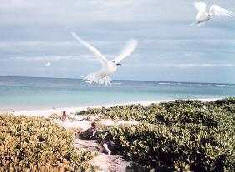|
BONN, Germany, September 18, 2002
(ENS)
Climate change is a "huge threat to migratory species," and we must do everything possible to limit this change, German Environment Minister Juergen Trittin told delegates from 80 countries and environmental groups at today's opening of a global conference on the conservation of migratory species.
The 7th Conference of the Parties to the Convention on the Conservation of Migratory Species of Wild Animals (CMS) will run for a week at the International Conference Centre Parliament Buildings in Bonn. Proposals covering some 36 migratory species will be discussed.
Trittin, a Green Party minister, said the German government has committed 500 million euros for climate change reduction programs, such as increasing the market share of solar and wind power, in part with the aim of improving conditions for migratory birds.
More migratory species are to be included under the CMS treaty during this meeting, said Trittin. Australia has proposed the listing of six large whale species for protection as migratory animals.
He warned that migratory ocean species such as whales, seals and turtles, need greater protection from oil spills at sea, and called for greater cooperation among governments to help these animals survive. There is a "fundamental need to globally coordinate nature conservation," Trittin urged.
Bonn formally became the headquarters of the CMS Secretariat this morning with signatures and smiles all around. The Convention came into being in 1979 as a result of the efforts of the government of Germany, the United Nations Environment Programme, and IUCN, the World Conservation Union.
On behalf of the Prince of Wales, Arnulf Müller-Helmbrecht, CMS executive secretary, praised the CMS as a “splendid champion” of vulnerable species for over 20 years. "A great deal has been achieved in the past 20 years by CMS," the prince said, citing the trilateral cooperation over seals in the Wadden Sea, and agreements to conserve small cetaceans in the Baltic and North Seas which are acting as models for agreements in other parts of the world.
The Prince of Wales urged nations to ratify a key treaty designed to save albatrosses and petrels. Many of the world's 24 species of albatross are vanishing as hundreds of thousands of birds each year become entangled and killed on fishing hooks of longline fishing vessels.
"These sea wanderers have developed their astounding powers of navigation over millions of years, but are now threatened by man - in particular, by use and abandonment of non-selective fishing gear and by incidental mortality as a result of commercial fishing activities," the Prince said in his statement.
Eight countries have so far signed the Agreement on Albatrosses and Petrels, but only two, Australia and New Zealand, have ratified it. Five nations must ratify the treaty to bring it into force, and officials hope this can be accomplished in early 2003.
Longline fishing vessels, which are setting millions of hooks globally each year, could be killing more than 300,000 albatrosses annually, experts estimate. The number of petrels, a kind of small albatross, being killed by longliners is unknown but is believed to be substantial too.
BirdLife International, an international coalition of national conservation groups based in Cambridge, UK, has launched a Save the Albatross campaign, with the support of the Prince of Wales.
BirdLife estimates that in 1994 one third of all albatross species were threatened with extinction. By 2000, this had risen to two thirds. One species, the Amsterdam Island Albatross, is down to just 90 individuals.
In Bonn, BirdLife representative John O'Sullivan explained that the fishing lines, carrying thousands of baited hooks, can be up to 130 kilometers (80 miles) long. "After being fired from the ship, they float on the surface. Sea birds, scavenging behind the boats, can take the bait from the hooks and be dragged underwater as the lines sink," he said.
Low cost solutions exist to reduce, and in some cases eliminate, the risks of these sea birds grabbing bait and drowning on the lines which the agreement would promote. Solutions include using defrosted bait, which means the lines sink faster, to firing the lines at night when most of the birds are resting rather than feeding.
Inexpensive modifications can be made to vessels so that
the lines are fired directly underwater though special tubes.
"It is vital that those countries with long line fishing fleets
take this Agreement seriously," said Müller-Helmbrecht.
Barry Baker, Australia's scientific counselor to the CMS,
said having five nations ratify the albatross and petrel
agreement is just the start. He said there are 15 countries
that can be classed as range states, nations were albatrosses
and petrels can be found. There are many more countries
with fleets operating in waters where the sea birds can be
found.
|
